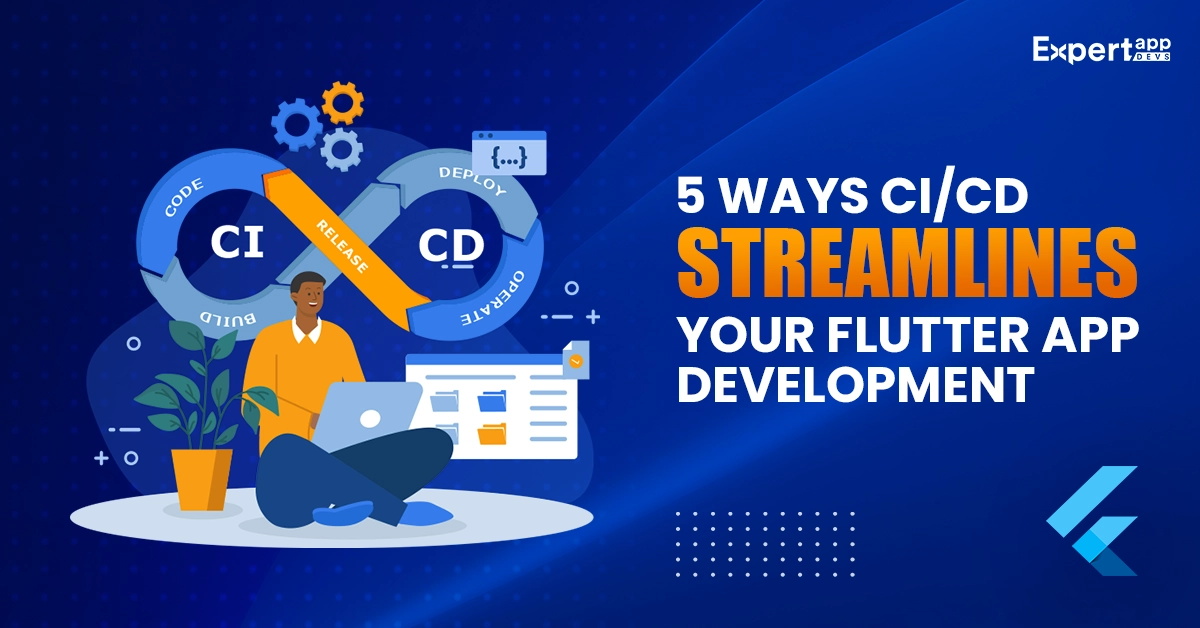Top 5 Ways CI/CD Streamlines Your Flutter App Development (For Faster Delivery & Lower Costs)
The business ecosystem is fast-paced. A slow runner would not be fit to survive in the cutthroat competitive environment. Adding to your woes, the traditional devt cycle makes it impossible to match the delivery pace and release your software faster.
Moreover, this approach also increases the cost of development and doesn’t assure code reliability. In the wake of these issues and the growing need to stay competent, you must adopt automation for Flutter app development. With over 52k live Flutter websites, it is crucial to ensure smooth development processes.
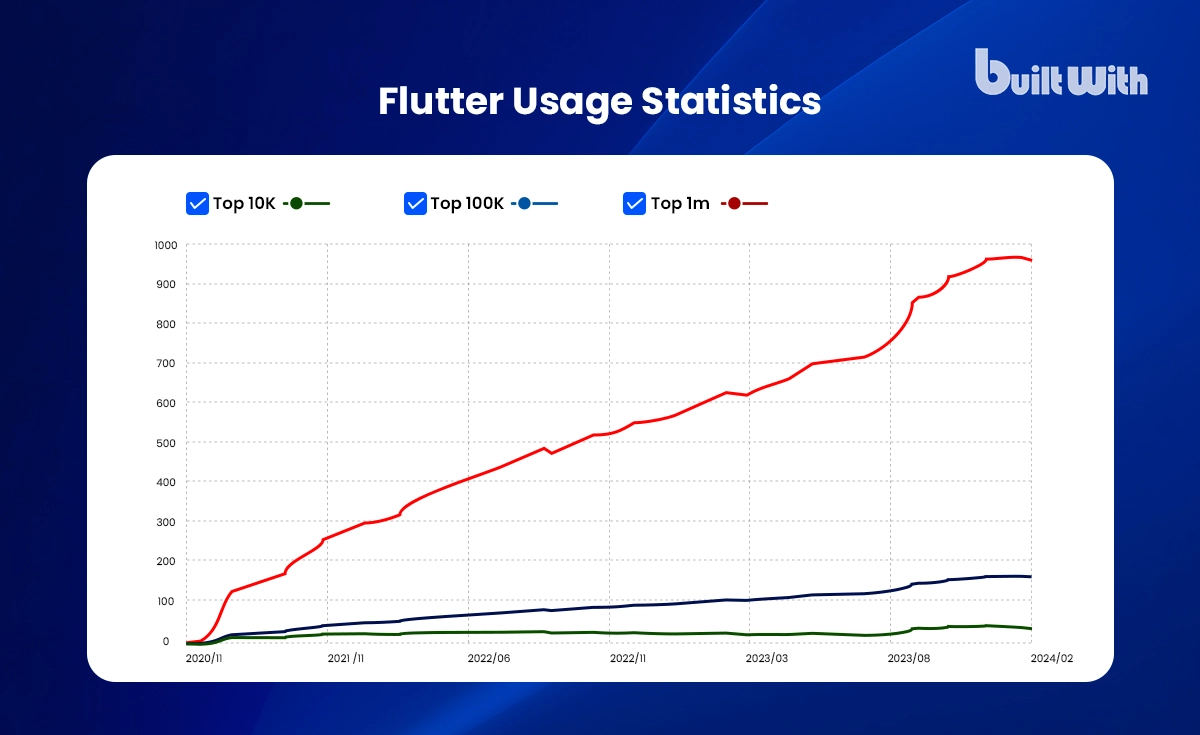
Integrating the CI/CD pipelines in the Flutter application development lifecycle can help you close the gaps that exist in traditional devt approaches. You can make informed development decisions and automate crucial parts of the workflow.
CI/CD can help you continuously improve the application, reduce resource utilization and enhance cost-effectiveness. This article will look at the benefits of integrating CI/CD for Flutter app to streamline the process.
What is the CI/CD Pipeline?
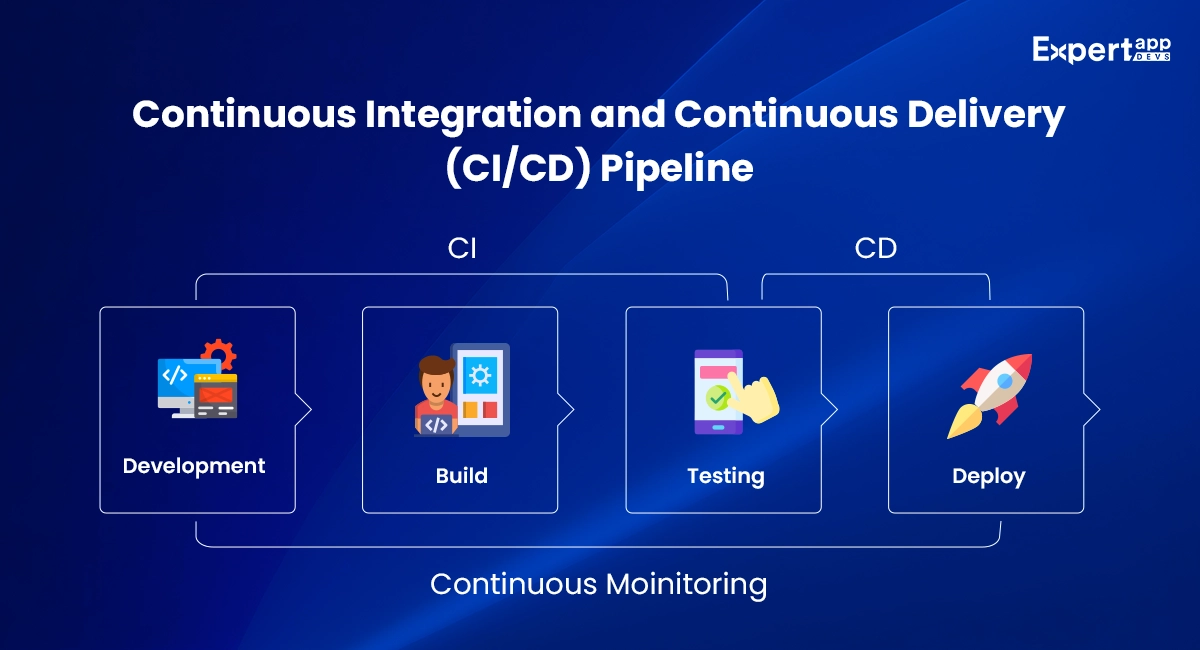
CI/CD pipeline is an automation approach that fosters continuous integration with continuous delivery to enhance software development. You can use continuous integration to automate the code changes and ensure it is integrated into the shared repository.
The pipeline automates the deployment and delivery by moving the code to the release stage. This is automated after the testing phase. Continuous deployment ensures every code is ready for release and automatically added to the production stage.
CI/CD pipelines help enhance code quality and ensure faster app delivery. It can foster superior solutions.
An Overview of the Continuous Integration Pipeline
As discussed, Continuous Integration is the practice of automating the code changes and its successful deployment into the shared repository. With each integration, you tend to automate the build, compilation, testing, and validation of the code.
The 5 Key Characteristics of Continuous Integration
#1. Frequent Code Integration: This approach allows your developers to commit the code changes into version control systems, such as Git. You can commit them multiple times in a day. This iteration would break down the entire task into smaller and more productive integrations.
#2. Automated Builds: The automated build will trigger as soon as a developer commits a single code. In this process, you would compile the code and eliminate the dependencies. It can also help execute the artefacts.
#3. Automate Testing: You can automate the build-to-test process to conduct unit and integration tests. It can also help you automate the acceptance tests. You can ensure the code changes don’t result in regressions or code breaks.
#4. Continuous Feedback: You are aware of the errors or failures in the build/testing processes immediately. This allows you to address them and rectify the errors for immediate resolution.
#5. Shared Devt.: This approach allows you to automate the integration and testing processes. It also allows you to reduce the conflicts that arise with the non-integration of the developers.
An Overview of the Continuous Deployment Pipeline
Continuous deployment is a software engineering methodology where the code changes that occur in the CI pipeline are automatically deployed to release environments. The developers can be sure that the code is ready for the production environments.
Using the Continuous Deployment approach in Flutter app development services can help deliver new features and bug fixes. It can also help improve the code rapidly.
The 4 Key Characteristics of Continuous Deployment
#1. Automates Deployment: Using the CD pipeline, you can automate the deployment process. As soon as code changes are integrated through the CI pipeline, you can ensure automated deployments into a production environment. This allows you to eliminate errors and accelerate code delivery.
#2. Employs Release Pipeline: You can set up a release pipeline that goes through multiple environments, including programming, staging and production. You can use these tests and validations to deploy a reliable and high-quality application.
#3. Incremental Updates: The continuous deployment pipeline allows you to deploy the updates incrementally. This allows you to update the app incrementally. You can use this approach to gain immediate feedback from the environment and deploy the apps sooner.
#4. Continuous Improvement: You can use the pipeline to collaborate with the team. It can ensure quick experimentation and extend a feedback-driven deployment.
Benefits of CI/CD Pipeline
#1. The pipelines ensure quick and frequent software delivery that can help you respond to changing market needs. It helps you align your software with the customer feedback.
#2. The pipeline can help you raise the bar for code development. You can use the automation to ensure you can identify the issues early. This can help you validate the application and ensure it is production-ready.
#3. You can reduce the risks by automating repetitive tasks and continuously monitoring the app. It also helps you commit the changes continuously to eliminate deployment failures.
#4. The pipeline allows you to collaborate on a project and ensure a seamless integration-to-testing cycle. It can help you foster a transparent environment for code integration and deployment.
#5. These pipelines can help you employ consistent development and deployment practices. It can help you be more reliable with software releases.
#6. The pipelines can reduce the overall build time and resource costs. This can help you minimize downtime and reduce expenses.
5 Ways CI/CD Streamlines App Development
If you are planning CI/CD pipelines, you must understand they can help streamline the app development process. Here are the five ways in which automation can help you.
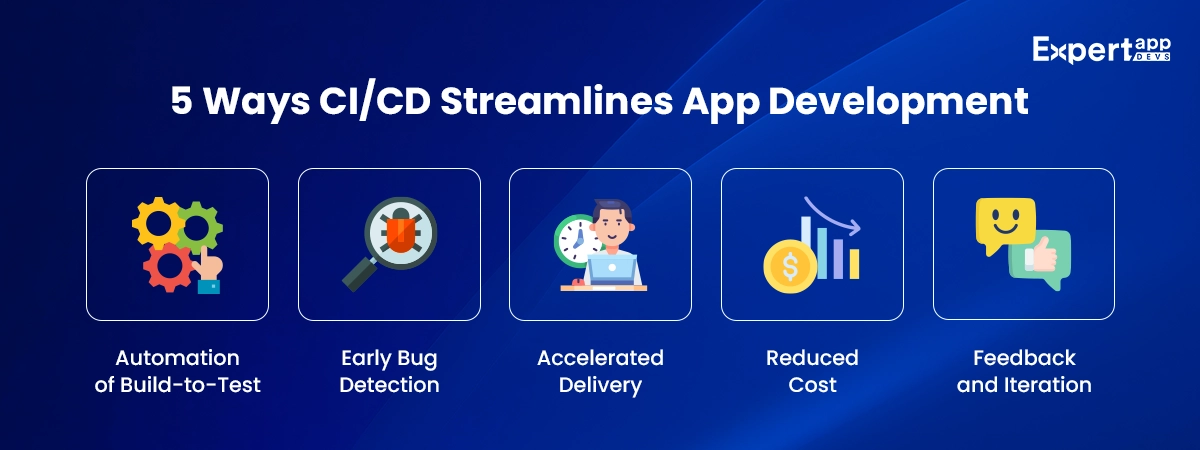
#1. Automation of Build-to-Test
When you are developing a Flutter application, you need to ensure the build and test processes work seamlessly. This would uplift the code quality and offer an efficient solution.
You can create an effective Flutter app devt workflow by automating the build and compilation. This would help you reduce the errors that are caused by the manual interventions.
You can also deliver more consistent and able workflows that reduce the risk of errors. Additionally, the automation can ensure quality code. You can also integrate the pipeline with Flutter frameworks to automate the different tests, including integration and UI testing. This would help you catch the bugs early and restrict regressions.
These tests can help you validate the individual components and units. You can also assess the integration of the system with the component for seamless usage. It helps the developer be more confident about the reliability of the functionality.
You can accelerate the feedback loops and detect issues faster with the automation. This way, you can deliver reliable and stable code to enhance user experience.
#2. Early Bug Detection
An early detection of the bugs in your software can help you deliver an innovative Flutter application. CI/CD practices can further the software's reliability by allowing developers to commit the code changes to a shared repository.
You can automate the code analysis to detect the bugs. It helps you scan through the entire codebase to determine the syntax errors and security vulnerabilities. You can also use the tools to implement the best practices and deliver quality code solutions.
The early bug detection also offers immediate feedback on the quality and performance of the code. You get immediate notifications on the tests and code analysis that can help you make the right decisions.
You can use these pipelines to reduce the time taken to detect the issues and speed up app delivery.
#3. Accelerated Delivery
This is one of the best ways in which CI/CD pipelines streamline mobile app development. When you integrate the pipelines into your Flutter application, it can automate the processes, such as code compilation, testing and deployment. You can also reduce the manual dependencies, as a result.
The continuous delivery ensures small and incremental updates that can help you launch the apps faster. Moreover, the iterative approach can enable the developers to deliver new features and improve the application faster. It fosters agility in your development lifecycle.
You can use the rapid feedback to identify and resolve issues. It can reduce the time-to-market and enable faster feature updates.
#4. Reduced Cost
It can reduce the cost and optimize resource allocation. The biggest thing it helps get done is reduce manual intervention. This naturally reduces the need for human resources.
The reduction in downtime and errors can also help you improve the deployment practices. It can also help you enhance the reliability and availability of the application, which reduces revenue loss.
By optimizing the resource across build, test and deployment, you can utilize the resources effectively. You can also maximize the infrastructure usage with minimal resource deployment.
The CI/CD pipelines can also reduce the maintenance cost for businesses. It offers emergency fixes, which can ensure more cost-effective ways of resolving the issues. You must hire Flutter app developers to ensure optimal resource utilization and effective build processes.
#5. Feedback and Iteration
The feedback and iteration processes within CI/CD pipelines can enhance software development processes. You can ensure the best experiences for the users of your Flutter application. Additionally, it can help you acquire the insights needed to understand the user’s pain points and preferences.
You can even use the testing and analytics to gain feedback on the application. This would help you refine the app and improve it to add new features and optimize the performance.
You can also use the CI/CD pipelines to update the app faster.
How to Integration CI/CD with Flutter App?
Here are all of how you can integrate CI/CD with the Flutter application. This guide will take you through all the points.
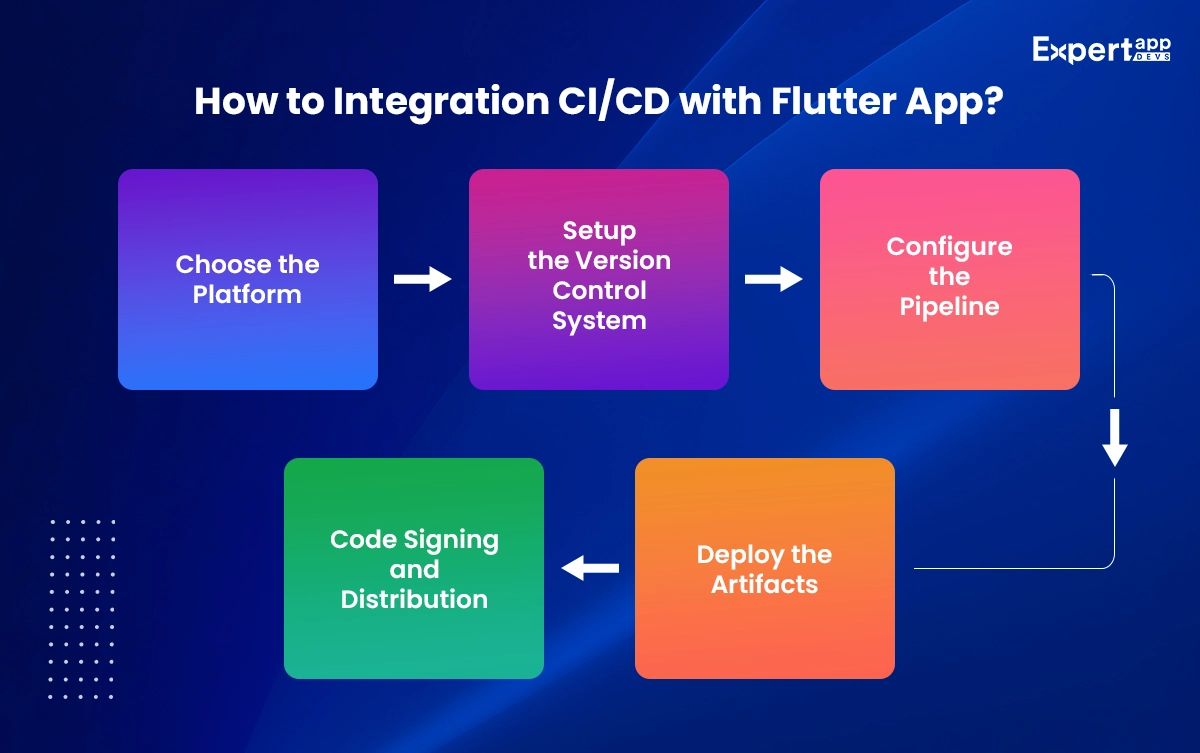
#1. Choose the Platform
Choose the CI/CD platform that can aid you in Flutter app programming. Jenkins, Travis, CircleCI, GitLab and GitHub Actions are among the top platforms that you can choose. You must look at the ease of use, integration with the Version Control System and support for the tool before using the platform.
#2. Setup the Version Control System
You must look at a version control system that can ably host the application. Version control systems can help you track the changes and trigger the CI/CD pipelines. This can help you commit the code and pull the requests.
#3. Configure the Pipeline
You must configure the pipeline to make sure it can help with building, testing and deploying the application. You must look for ways to write the configuration files. For instance, YAML and JSON can help you with configuration. You can also build a visual interface to configure the pipeline.
#4. Code Signing and Distribution
Distributing the app across devices must ensure you have configured the code for these devices. you can ensure that the code is complete with the certificates and keys. You should also integrate the pipelines with the app distribution services. These include Firebase App Distribution and TestFlight.
#5. Deploy the Artifacts
You must build and deploy the artefacts for the particular environments. It is equally crucial to publish the releases for the app stores and distribute the builds. You can also use the pipeline to deploy updates into the production server. This will help you manage the deployment securely.
#6. Monitor & Troubleshoot
you can continuously monitor the CI/CD pipeline execution. It is crucial to track the metrics, such as build status, test insights and the success of deployment. You can also use the notifications to get real-time updates on the issues and failures.
#7. Document Regularly
Conduct a detailed documentation of the CI/CD pipeline. You should ensure the best practices and setup instructions are mentioned. It is equally important to ensure seamless collaboration for efficient devt.
Top 5 CI/CD Tools for Mobile App Development
Here are all the top CI/CD tools that you can use to develop Flutter applications for the business. These tools can help with build, test, compilation and deployment.
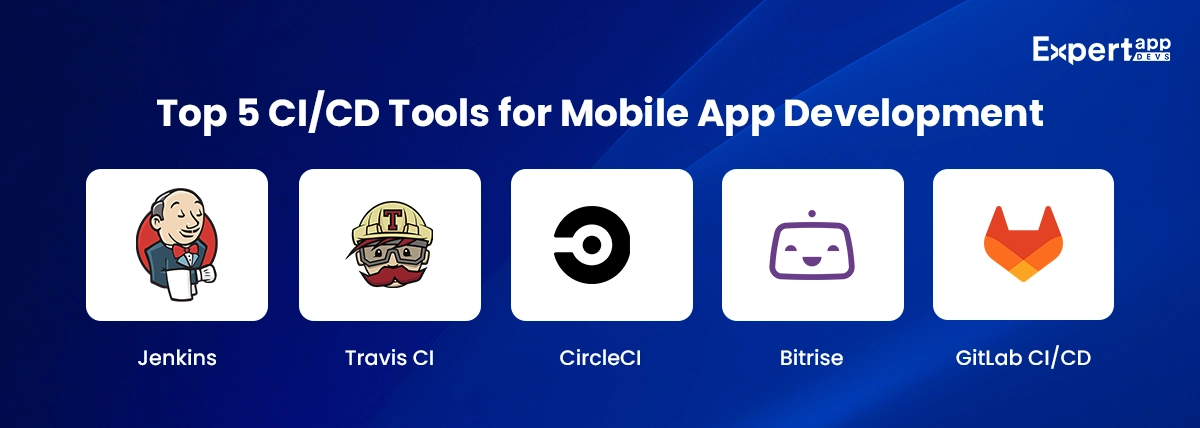
#1. Jenkins
This is one of the most popular and widely used open-source automation servers. It can help with continuous integration and delivery for swift mobile app development. This tool extends a vast app development ecosystem that is complete with plugins for Android and iOS. You can also use it across version control systems like Git.
#2. Travis CI
This is a cloud-based pipeline that can help developers with building and testing Android or iOS applications. you can integrate this tool with GitHub repositories to offer ease of configuration with YAML files. It can help improve the build speed and ensure quick distribution.
#3. CircleCI
This cloud-native CI/CD platform can help you offer app devt with the required speed and scalability. You can use it to build, test and deploy the applications. this tool also allows you to customize the workflows and cache the dependencies. It helps integrate with the version control systems.
#4. Bitrise
This is a CI/CD platform that can help with Flutter app development. It uses pre-configured workflows and integrations that help with building, testing and deploying the applications. It comes with a user-friendly interface and extensive library. You can easily gain built-in support for code signing and app distribution features.
#5. GitLab CI/CD
This platform allows native integration of the repositories and project management platform for best solutions. This tool uses shared runners and custom pipelines. It can also extend features like Docker-based runners and parallel execution.
Conclusion
CI/CD for Flutter app development is an absolute necessity for businesses trying to survive the competitive environment. It can close the gaps that exist in the traditional development process. You can use this integration to increase time-to-market and improve the app quality.
You can also reduce costs and improve responsiveness to customer feedback by adopting automation. It also helps ensure quick detection of bugs and incremental feature updates. You can stay relevant in the competitive environment while offering user-centric solutions.
To ensure successful adoption of CI/CD in Flutter application development, you need a good Flutter app devt company. They can help recognize the most efficient ways to integrate the pipelines into your development process.
Expert App Devs is a top-notch Flutter app development services provider. Connect with us to help you access high-performing solutions aligned with your goals.
 Jignen Pandya
Jignen Pandya
